DO-IT News March 1996

Volume 4, Number 1
Below are the articles of the DO-IT News March 1996 newsletter. These articles can also be seen all on one page at the Full Newsletter option.
Director's Digressions
Recently, I posed some questions on our electronic discussion lists for DO-IT Scholars, Ambassadors, and Mentors about social life in college. Some great ideas emerged. Below I have listed some of the responses, with minor editorial changes. Perhaps you, or someone you know, will find them helpful in preparing for college life.
- Why is it important to have a successful social life in college?
- "As far as social life, I can't stress enough the importance of at least trying to get out and be involved. It really doesn't matter in what; clubs, teams, friends, whatever...It won't be easy, but it's worth it."
- "Social life in college is imperative for your own sanity and for learning how to interact with people. In many cases, people make lasting friendships in college."
- "I found people to be a lot more open in college than in high school, and I learned about socializing with others in college, and am still learning in graduate school. In college, I made most of my friends in classes, in the dining hall, at foreign language table, and at the Lutheran Ministry at my university. I am still in touch with several people I met during my college years."
- "I think I've learned from being with people. I'm not so self-conscious or uncertain of myself. Friends have also reintroduced me to things like crayons and taught me card games and so on. Not only is it fun to hang out with people, but it's emotionally uplifting. Life wouldn't be as worthwhile without friends."
- "I think college consists of both social and academic learning. As I look back on my undergraduate days, I remember a lot more social times with other people than I do lectures or exams. And I'm not really a people person, either. I know I learned a lot from the social end of things. Some of that learning was painful, because when you make friends, people sometimes give feedback which you need but wouldn't otherwise get about behavior and attitude. This is part of people relating to one another, and causes necessary growth. Mostly, though, socializing is fun, and being by yourself is lonely."
- "College teaches you many things if it works right. How to interact with many people in many different ways and on many different levels, but it also gives you information and hopefully enhances problem solving and thinking for yourself skills."
- "...those that come out of college without social interaction will have trouble. We live and work in a world where groups of people solve problems. Especially in the areas of science, math, and engineering. Therefore, these people coming out of college will have trouble succeeding because they do not have the higher social skills required in this situation."
- "In college, one has the challenge of balancing academic demands with social pleasures. That is something that will be important later on, too."
- "I believe that this type of socialization creates professional associations that last. Now that I am a computing professional, these relations continue. We have careers in common and I rely on others to give me important information. My friends also rely on me to feed them information."
- "...in many cases for disabled people, socializing is the key to academics. ...[blind students] need sighted people that are part of the class, in the same section of the book, listening to the same lectures, doing the same homework to help us with them. With their help we can get the descriptions we need. Therefore, socializing is, as I have said, imperative. Academics is the road we use to get there. After academics, or dorm life, we can branch out into wider social circles. It is a progression."
- "Having a successful social life will make your college career easier for many reasons. First, with a social life, a person does not feel lonely because you have friends to talk to and listen to. Second, you can get help from your friends if you need help. For example, you can study those killer midterms with friends! Third, a person would have more chances to form a relationship which we believe is important to people. Fourth, it will make you a 'well rounded' person and most companies will look for that when you look for a job."
- "I have seen people who had a good social life in college and did poorly in college. The key is to balance your social life and college. This is a key skill that you need to learn in college. In your professional career, you need to do this with your career and family."
- What special issues face students with disabilities interested in developing a satisfying social life?
- "I find it's difficult to make friends because people judge me before they know me. You all probably know I'm quite shy, but to people who actually know me, I'm quite the 'hyper hellion'. I think this has a lot to do with my disability, because it just turns in to a label for me to wear. I know it probably sounds like I'm being a weenie, but it's too true. You try to explain your disability, which is part of you, and all you get back is sympathy. The Internet...allows me to escape my label. I guess you get a chance to know a person spiritually first..."
- "In college and 'real' life you need a lot of support to even survive on your own."
- "I think that blind people face the particular challenge of not being able to walk up to someone with whom they would like to talk unless they hear their voice, or the person introduces him- or herself. In the dining hall, for example, I always asked someone to help me find a seat, but that person would not necessarily know the people I liked to sit with, so it was a game of chance. Sometimes, I met new people, sometimes I happened to sit next to good friends, and sometimes I was unable to join in the conversations around me. However, by making friends in certain interest groups and arranging to meet friends for a meal, I was able to keep in touch with the people I cared about."
- "I did find that my disability got in the way of getting friendly with some of the students, but they weren't worth knowing anyway. The others who accepted me as an equal were the ones I stuck with."
- "My social contacts came from communities of shared interest. Pretty much any religious or political interest, extracurricular activity or hobby can work if you use it. For me, the debate team and the foreign language house provided communities where I felt accepted and had a good time."
- What strategies can you use to help create a successful social life in college?
- "You just need to smile at people and look receptive. You should take some time to go to a common place in your dorm and talk to people there."
- "Living in the dorms helped immensely in immersing me in the college social life. Without the contact in the dining halls, my social life would only have been half as good at best."
- "My social life revolves mostly around people on my dorm floor or in the NASA program. I'm in Intervarsity Christian fellowship, too, but I got involved in that through people on my floor this and last year."
- "A lot of my social life surrounded my career goals. I wanted to be a programmer and hung around the computer lab - not exactly beer and pizza, but it was very social. I think I learned more from the other students than from my professors. There was great interaction and sharing of ideas and concepts. ...Oh, I managed to eat pizza and drink beer, but not in the computer lab."
- "...there are many strategies to fulfilling social life in college. A popular way is to join a fraternity or a sorority on campus. Through this, you can get a lot of friends from your house. Another way is to join a club that matches your interests. I prefer this way because it matches your interests with other people. I have a lot of friends by joining a club. The third way, similar to joining a fraternity, is to live in a dorm."
- "Socializing that is connected to your schoolwork is very valuable, too. I made one good friend in college in a class we were taking together. Every week, we got together and worked on the homework together. The best part was that we were able to help each other, so that it was not one-sided. During my first year as a graduate student, I also frequently discussed problem sets with my classmates. This gave me good experience for collaborating with others on research."
- "I understand that for some people making friends is not as easy as it is for others. But if you would treat people in a friendly manner, they are going to treat you the same. Whereas, if you feel yourself so different from others and would not talk to them, then you will find yourself totally out of place. Everyone is the same and different too. This is what is so good about the world."
Recruiting DO-IT Scholars '97
DO-IT Scholars are high school students with disabilities who are interested in college, science, engineering, mathematics, or technology and have the aptitude for, and interest in attending college. Scholars participate in live-in summer sessions at the University of Washington and are loaned computers and adaptive technologies as needed. They must reside in the United States. Local travel in Seattle, room and board and academic accommodations are provided without charge. DO-IT is recruiting students who are Freshman now to be Scholars in 1997. Contact the DO-IT office for an application packet. The deadline for application submission for 1997 is December 31, 1996.
Technology Tips
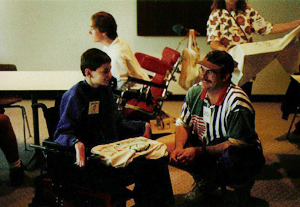
The Technology Tips column in the December 1995 issue of DO-IT News gave an overview of what the World Wide Web is and why it is such a powerful and flexible Internet resource. This issue's column discusses how to design Web pages that are accessible to all potential users, regardless of disability.
DO-IT's Web Design Philosophy
The varied features of the World Wide Web are attractive to a wide variety of users. Yet many Internet surfers are unable to view graphics and photos because of visual impairments, or cannot hear audio because of hearing impairments. DO-IT's philosophy in designing its pages is to practice "universal design" principles so that all visitors to our Web pages can access its content. Universal design means we concentrate on content rather than flashy graphics and audio and consider the full spectrum of potential users. When designing a document, we attempt to make the material, whether it is a menu item, graphic, or video clip, as accessible as possible.
Web developers should be aware that a diverse group of people may visit your Web pages. Some visitors:
- cannot see graphics because of visual impairments
- cannot hear audio because of hearing impairments
- use slow connections and modems and choose not to view graphics
- have difficulty when screens are unorganized, inconsistent and cluttered and when descriptions and instructions are unclear. These difficulties may occur because they have learning disabilities, English is their second language, or they may be younger than your average visitor
Perhaps the most important consideration in designing Web pages is to not require that a Web site visitor use a specific browser to access information. Numerous Web sites require the use of a particular version of Netscape. Though this is the most popular browser currently used, developers should acknowledge that it's not the only option. For Web site developers, accessibility to the maximum number of potential customers should be a top priority.
Many of the accessibility issues and tips described below make a favorable impression for all Web users, regardless of disabilities or special needs.
General Web Design Tips
- Maintain a simple, standard page layout throughout the document.
Once a method of layout is determined for your page(s), stick with it. A consistent interface for your pages will make it easier for anyone contacting your site to find and access information. Buttons and navigational links should always appear in the same places (top, bottom or both) on a page, and headers should follow a consistent format.
Who Benefits? Everyone, particularly people with learning and visual impairments and for whom English is a second language. Consistency and simplicity are the keys to accessibility. - Use universally recognized HTML tags.
Don't use formatting tags (such as <BLINK>) that are only supported by one Web browser. The HTML version 2.0 standard is the best bet for compatibility with a wide variety of Web browsers.
Who Benefits? Anyone using a text-based browser, particularly users who are blind. - Test your pages with a variety of Web browsers.
Test your Web pages on at least three different Web browsers. One of the browsers tested should be a text-based program such as Lynx. This will ensure that pages are accessible to people who may be using a different browser than you. If possible, also examine your pages using browsers on different platforms (Macintosh, PC and X). Though it is possible, with some programming on the server side, to determine what browser someone is using and make certain types of information available, most developers do not have the resources available to do this.
Who Benefits? All potential Web site visitors. - Provide alternate text for browsers that can't display images.
Many people cannot see pictures or drawings. This can be due to a disability or as a result of using a text-based browser. The <ALT> tag when used with a graphic will allow a written description of the image to be conveyed to the user. The <ALT> tag is an excellent way to make a graphical button accessible to those using text-based browsers. Also, for those developers using graphical bullets, an ALT tag can contain other text that provides a good alternative such as an asterisk or text.
Who Benefits? Users who cannot see images. - Avoid using tables.
Tables are not supported by all browsers and can be confusing for people using voice output to read. Screen reading software cannot differentiate between columns so that text is read constantly from left to right.
Who Benefits? Anyone using a browser that doesn't support tables and anyone using voice output to read text. - Avoid using a single mode of delivering information other than text.
If information is to be conveyed using audio or video files, provide text-based alternatives. For example, if an audio file contains dialogue or lyrics, a transcript of the file will enable someone with a hearing impairment to access it. Also, video may contain information that can be provided in descriptive text form.
Who Benefits? Visitors who may be blind and/or deaf. - Provide text alternatives to image maps.
Image maps are graphics that contain multiple areas that, when selected with a mouse or other pointer, jump to another web page or section. The only method of making image maps accessible is to provide a text-based alternative.
Who Benefits? Anyone using a browser without graphics capability, those who cannot see images, and users who have turned off loading of graphics. - Don't use complicated backgrounds.
Many backgrounds do not provide enough contrast for easy viewing. Users with visual impairments often invert their screen colors due to light sensitivity or other needs. Backgrounds and other formatting that changes the color of text can make a page inaccessible to someone with a visual impairment or for someone with a reading impairment. If a custom background must be used, select something that provides good contrast with your text.
Who Benefits? Visitors with visual impairments and people accessing via slower connections.
Resources
Issues related to design and specific disability types are discussed at www.washington.edu/accessibility/checklist/. Many of the tips provided in this publication were found at this useful site.
Mentor Profile Bapin Axbhatta
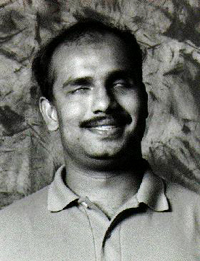
I am a 25-year-old male. I am both deaf and blind, and I come from India. I am currently in an undergraduate program at University of Arkansas at Little Rock, majoring in political science.
I was brought up in a village twenty miles south of Calcutta. The village is mostly filled with farmlands and forests. It has no paved roads, vehicles, or fancy markets but a few food bazaars. Eighty-five percent of its population lives in poverty and illiteracy. It does not mean they have no homes; they get free land on which they build huts from mud, hay, and bamboos. I feel gifted as I sometimes think how God has provided me with a wonderful family. Most people in this kind of culture would be too embarrassed to show their disabled children to the public.
When I was a child, I was not blind. I was only born deaf; why I am deaf is unknown. Fortunately, my parents are well educated and could understand that my needs were very special. At the age of two, my mother taught me how to speak Bengali, my native language. She used many artistic ways to describe how to make the sound of a letter by moving her lips and had me feel her throat for vibrations. I could then speak and lipread; people that understood me were the ones who had heard my voice often.
When I was six years old, I was sent to a school in Calcutta near my mother's family's house. As I was deaf, I had to sit in the front of teachers to be able to lipread what was said. I had a hard time there because the kids were mean and picked on me a lot as I could not hear. They made fun of my mistakes when I was trying to understand what the teachers were saying. The teachers also did not understand what was going on; they let this situation go on and on. At that time, I was too innocent to deal with the situation so instead I got really frustrated and behaved badly. The school got tired of me and expelled me after six months. I went back home to the village.
One day my mother decided to test my vision. She put her hand on my right eye and asked if I could see from my left eye. I said yes. Then she put her hand on my left eye. I was terribly shocked to learn that I could not see anything from my right eye! I was afraid to tell her the truth so I lied and said yes. She was clever enough to use an object before my eye and asked what it was. I said the name and she said wrong. So she told me not to worry about being blind in my right eye. Although she felt very sad, she was still glad to have discovered the problem I had. At this point, I froze into a deep thought about how this all happened. I then remembered something: I told my mother that I was digging soil one day some time ago with one older boy from my neighborhood. He accidentally threw the soil into my right eye. Maybe this was the cause that I lost sight in one eye, but I never realized this since I still could see in the other eye.
My father sent me to a hospital where I stayed for three months. Nothing succeeded; the doctor said that the retina had been badly damaged. So I went back home where I was admitted to a nearby school. At first this school did not accept me, because they thought I could not do what other students did. My father persistently persuaded the master of this school to let me in. I was then seven and half years old when I was in the first grade.
When I was half way through the second grade, I had a fight with a boy who decided to throw ash-like dirt into my eyes. Again, I was hurried to the hospital. The doctor could not get my sight back fully as the retina was already detached. I slowly became totally blind during a three-month period. I was so frightened and felt lost as I did not know how to live or move around freely without any sight. I had to quit school. After the accident, my young brother was born so it was tough for my family to handle many situations at a time.
During the next four-year period, my father tried to find a way for me to resume my education. Unfortunately, all the schools for the blind in India would not accept me as they had no provisions for working with deaf students. But with the grace of God, my father met a principal at a blind School who had gone to Perkins School for the Blind in Watertown, Massachusetts years ago. She told him that Perkins would be an excellent place for me to go.
Since the government in India would not aid me either financially or otherwise, the process in making arrangements for me to enter Perkins was complicated. However, Perkins very generously offered me scholarships for the time I was enrolled as a student there. Were I to have remained in India, I could never have succeeded going through school and making it to college, due to the paucity of services there.
In September 1983 my father and I came to the United States. He acted as my interpreter to translate from English to Bengali until I learned enough English to go on my own. So I busied myself learning English, Braille, and American Sign Language.
Coming to the United States has changed my life significantly. I still cannot believe how terrible a boy I was in the past. But at least I am now very happy with my life although I cannot see anything. Many great technologies here enabled me to be as independent as those who are hearing and sighted. When I think about all of that, I am even more surprised to realize that I am really in college where I am now majoring in political science! I am very grateful for what I have received and that the University of Arkansas has the accommodations necessary to facilitate my academic progress. I expect to earn a bachelors degree in May 1997 and then hopefully to go to law school.
Throughout my life, I have developed a strong interest in helping others who are in my situation. Knowing all about laws and becoming a lawyer myself, I want to be able to lobby and convince the government to look into the possibilities of establishing various services to meet the needs of people with disabilities. This includes my goal to work with those with disabilities to ensure their civil rights and equal opportunities for achievement.
Because of my strong interest in issues for persons with disabilities, I have traveled to many countries to attend conventions based on various perspectives toward problems encountered by deaf-blind people. I was once in Russia where I was asked to meet with commissioners of several agencies that worked to protect the rights of people with disabilities. This was where it led to my interest in becoming a lawyer.
As for my hobbies, I love computing, woodworking, traveling, obtaining new cultural experiences, creative writing, cooking, sewing, participating in sports, and the list goes on! At this time, I am mainly interested in traveling to different places to learn more about the perspectives that different parts of the world offer toward deaf-blindness.
If you have any questions, just ask me. I'm here to help you. I'm here as your friend if you need anything. Please feel free to email me anytime you need someone to talk to, to discuss problems with, to just "hang out" with over email. Hang in there, and take good care of yourselves!!! :)
All smiles!
Bapin
axbhatta@ualr.edu
Fun With Sumi
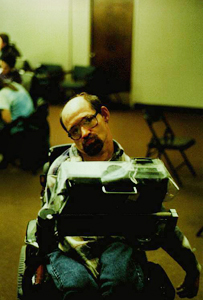
A great showing of DO-IT Scholars was present the night of August 14 of the 1995 DO-IT Summer Study session. Scholars were eager to change pace after a day of lectures and classes on the University of Washington campus. An enthusiastic group listened as I spoke about sumi art history with my electronic comunication device. My husband, Alan King, showed a slide collection of his work as an artist with a disability. Alan also speaks with an electronic device called the Liberator. Then the group got down to the real business of creating art. Sumi art painting was new to many of the students, but they all appeared to be having a great time. By using their mouths, feet, hands, or heads, the Scholars expressed themselves through the medium of black sumi paint and brushes of different sizes. Paint brushes were making straight lines, curved lines, along with thin and thick. Some students are natural born artists. We think they have the artistic capabilities to set up their own art show some day.
Wes, Phase II Scholar
"I had been having lots of fun at the DO-IT program and was thinking that they must be running out of ideas by now to keep us entertained. My thought was interrupted when they announced the sumi art project. Here was something I really enjoy doing (art/painting that is). All the participants enjoyed this activity. I would be interested in doing it again. It felt good when people complimented me on my painting."
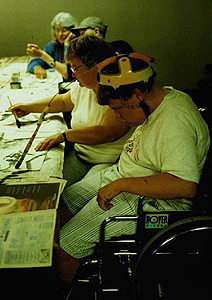
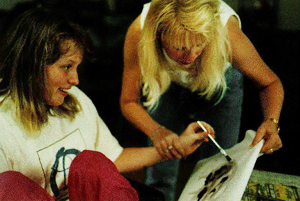
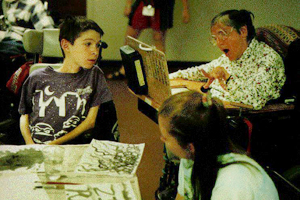
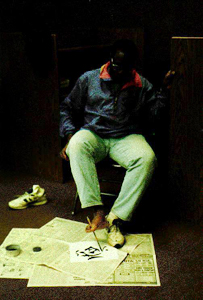
DO-IT Pals
You've heard of the DO-IT Scholars. You've heard of the DO-IT Campers. You've heard of the DO-IT Mentors. Well, watch out for the DO-IT Pals! DO-IT Pals form an electronic community of pre-college students from around the world with disabilities who support one another in their efforts to pursue college degrees and careers in science, engineering, mathematics and technology. They communicate with each other, get advice from DO-IT Mentors and participate in projects throughout the year. To become a DO-IT Pal you must:
- be a high school freshman, sophomore, or junior
- have access to a computer and the Internet
- be interested in attending a 2- or 4-year college
- have interests in science, engineering, mathematics or technology
- want to communicate with and work together with other students with disabilities who have common interests
Contact the DO-IT office for a DO-IT Pal application packet.
DO-IT Scholars Become Bikers
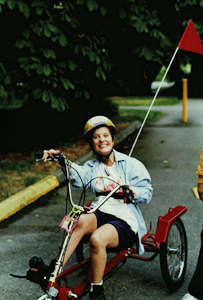
While riding your bike on the Burke Gilman Trail near the University of Washington on August 17, 1995, you might have seen something a little different. You would have seen bikes with special adaptations. These special adaptations were made for people like me. People with various types of disabilities had a chance to ride bikes on the UW campus. It was one of many activities held for DO-IT Scholars. This activity gave us the opportunity to do the unimaginable.
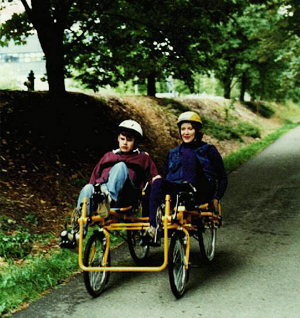
Ski-For-All made this event possible. They customize their bikes to cater to different abilities. For someone with quadriplegia, they have a two person bike so one person can pedal and the other can enjoy the ride. People with no use of their legs can pedal with their hands. For unsteady people, they gave you a seatbelt. Most of the bikes have three wheels, so you don't have to worry about tipping over.
All of the DO-IT Scholars who participated that night said they had a blast. It also gave us some exercise. Thanks, Ski-For-All, for the use of the bikes. We appreciated it a lot.
Off The Net I
Cartoon Law I
Any body suspended in space will remain in space until made aware of its situation.
Daffy Duck steps off a cliff, expecting further pastureland. He loiters in midair, soliloquizing flippantly, until he chances to look down. At this point, the familiar principle of 32 feet per second takes over.
Cartoon Law II
Any body in motion will tend to remain in motion until solid matter intervenes suddenly.
Whether shot from a cannon or in hot pursuit on foot, cartoon characters are so absolute in their momentum that only a telephone pole or an outsize boulder retards their forward motion absolutely. Sir Isaac Newton called this sudden termination of motion the stooge's surcease.
Cartoon Law III
Any body passing through solid matter will leave a perforation conforming to its perimeter.
Also called the silhouette of passage, this phenomenon is the speciality of victims of directed-pressure explosions and of reckless cowards who are so eager to escape that they exit directly through the wall of a house, leaving a cookie-cutout-perfect hole. The threat of skunks or matrimony often catalyzes this reaction.
Cartoon Law IV
The time required for an object to fall twenty stories is greater than or equal to the time it takes for whoever knocked it off the ledge to spiral down twenty flights to attempt to capture it unbroken.
Such an object is inevitably priceless, the attempt to capture it inevitably unsuccessful.
Cartoon Law V
All principles of gravity are negated by fear.
Psychic forces are sufficient in most bodies for a shock to propel them directly away from the earth's surface. A spooky noise or an adversary's signature sound will induce motion upward, usually to the cradle of a chandelier, a treetop, or the crest of a flagpole. The feet of a character who is running or the wheels of a speeding auto need never touch the ground, especially when in flight.
Cartoon Law VI
As speed increases, objects can be in several places at once.
This is particularly true of tooth-and-claw fights, in which a character's head may be glimpsed emerging from the cloud of altercation at several places simultaneously. This effect is common as well among bodies that are spinning or being throttled. A 'wacky' character has the option of self-replication only at manic high speeds and may ricochet off walls to achieve the velocity required.
Cartoon Law VII
Certain bodies can pass through solid walls painted to resemble tunnel entrances; others cannot.
This trompe l'oeil inconsistency has baffled generations, but at least it is known that whoever paints an entrance on a wall's surface to trick an opponent will be unable to pursue him into this theoretical space. The painter is flattened against the wall when he attempts to follow into the painting. This is ultimately a problem of art, not of science.
Cartoon Law VIII
Any violent rearrangement of feline matter is impermanent.
Cartoon cats possess even more deaths than the traditional nine lives might comfortably afford. They can be decimated, spliced, splayed, accordion-pleated, spindled, or disassembled, but they cannot be destroyed. After a few moments of blinking self pity, they reinflate, elongate, snap back, or solidify. Corollary: A cat will assume the shape of its container.
Cartoon Law IX
Everything falls faster than an anvil.
Cartoon Law X
For every vengeance there is an equal and opposite revengeance.
This is the one law of animated cartoon motion that also applies to the physical world at large. For that reason, we need the relief of watching it happen to a duck instead.
Cartoon Law Amendment A
A sharp object will always propel a character upward.
When poked (usually in the buttocks) with a sharp object (usually a pin), a character will defy gravity by shooting straight up, with great velocity.
Cartoon Law Amendment B
The laws of object permanence are nullified for "cool" characters.
Characters who are intended to be "cool" can make previously nonexistent objects appear from behind their backs at will. For instance, the Road Runner can materialize signs to express himself without speaking.
Cartoon Law Amendment C
Explosive weapons cannot cause fatal injuries.
They merely turn characters temporarily black and smoky.
Cartoon Law Amendment D
Gravity is transmitted by slow-moving waves of large wavelengths.
Their operation can be witnessed by observing the behavior of a canine suspended over a large vertical drop. Its feet will begin to fall first, causing its legs to stretch. As the wave reaches its torso, that part will begin to fall, causing the neck to stretch. As the head begins to fall, tension is released and the canine will resume its regular proportions until such time as it strikes the ground.
Cartoon Law Amendment E
Dynamite is spontaneously generated in "C-spaces" (spaces in which cartoon laws hold).
The process is analogous to steady-state theories of the universe which postulated that the tensions involved in maintaining a space would cause the creation of hydrogen from nothing. Dynamite quanta are quite large (stick sized) and unstable (lit). Such quanta are attracted to psychic forces generated by feelings of distress in "cool" characters (see Amendment B, which may be a special case of this law), who are able to use said quanta to their advantage. One may imagine C-spaces where all matter and energy result from primal masses of dynamite exploding. A big bang indeed.
Off The Net II
Kids say the darndest things. Some grade school teachers must agree with that, because they keep journals of amusing things their students have written in papers. We've listed a few examples.
- The future of "I give" is "I take."
- The parts of speech are lungs and air.
- The inhabitants of Moscow are called Mosquitoes.
- A census taker is a man who goes from house to house increasing the population.
- Water is composed of two gins. Oxygin and hydrogin. Oxygin is pure gin. Hydrogin is gin and water.
- (Define H2O and CO2.) H2O is hot water and CO2 is cold water.
- A virgin forest is a forest where the hand of man has never set foot.
- The general direction of the Alps is straight up.
- A city purifies its water supply by filtering the water then forcing it through an aviator.
- Most of the houses in France are made of plaster of Paris.
- The people who followed the Lord were called the 12 opossums.
- The spinal column is a long bunch of bones. The head sits on the top and you sit on the bottom.
- One of the main causes of dust is janitors.
- A scout obeys all to whom obedience is due and respects all duly constipated authorities.
- One by-product of raising cattle is calves.
- The four seasons are salt, pepper, mustard and vinegar.
- The climate is hottest next to the Creator.
- Oliver Cromwell had a large red nose, but under it were deeply religious feelings.
- The word trousers is an uncommon noun because it is singular at the top and plural at the bottom.
- Syntax is all the money collected at the church from sinners.
- The blood circulates through the body by flowing down one leg and up the other.
- In spring, the salmon swim upstream to spoon.
- Iron was discovered because someone smelt it.
- A person should take a bath once in the summer, not so often in the winter.
DO-IT Introduces New Video
DO-IT is proud to announce our newest videotape, College: You can do it!. It features students with disabilities sharing their experiences of transitioning from high school to college. Included with the videotape is a brochure summarizing the content of the video and a handout profiling the speakers. This packet would be useful for students with disabilities who would like to go to college; parents; teachers; and service providers. If you would like to order this, or any DO-IT videotape, fill out the Video Order Form and send it to DO-IT, 4545 15th Ave. NE., Room 206, Seattle, WA 98105-4527.
SerenityMOO
Len Burns and I have been setting up a MOO (an interactive site) on-line, called SerenityMOO that is mainly dedicated to making on-line access for those of us with disablities equal to those of us without. We've been running for almost three months now.
I'm very excited about a new project at SerenityMOO! Patrick Somers (known as LocalDude at Serenity) of Marysville, WA, had the novel idea of simulating blindness on-line and he made it so. Patrick himself is not blind, by the way. He created a room where you cannot identify a person by their name, but by a symbol. For instance, normally you would see "JennyLin says, Hiya all!". But in this room, you would see "$$Hiya all!$$". The point is to identify with the person by his or her MOOspeak (the way they type) or by his or her symbol, the way a blind person would identify with a voice and not a face. I was so incredibly thrilled with his invention, that I had to write this article to tell you all!
If you would like to visit this great invention first-hand, e-mail me and I will gladly give you a character. SerenityMOO will later be opened to the public.
jennylin@u.washington.edu
DO-IT at Camp Courage
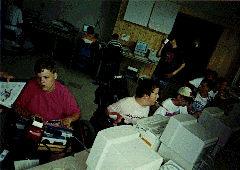
College Preview Camp is an opportunity for teens with physical disabilities and/or speech, hearing or visual impairments to get an introduction to college life and get hands on experience with the Internet. The session is offered through a partnership between the University of Washington's DO-IT project and Courage Center in Minnesota.
Campers learn to access the wealth of information and support that is available on the Internet. They participate in daily workshops on topics ranging from how to choose and apply to a college to how to take a college campus tour on the 'Net. Sheryl Burgstahler, DO-IT Director, will be providing most of the Internet instruction. Scholars Jenny and Anthony will be her assistants.
Collge Preview Camp is not all work and no play - it is camp after all! The schedule allows ample opportunity to participate in typical camp activities like horseback riding, overnight camping, fishing, swimming, and other camp programs such as parties, dances and more.
College Preview Camp is open to any young person who has completed seventh grade or higher and has college potential. Although Camp Courage primarily serves Minnesota, Wisconsin, Iowa, South Dakota and North Dakota, participants from other states are welcome. If you would like to know more about costs and other details regarding this or any Courage camping program, contact:
Courage Center Camping Department
3915 Golden Valley Road
Golden Valley, Minnesota 55422
Voice: (612) 520-0504
TTY: (612) 520-0245
Email: camping@MTN.org
DO-IT Mentor Honored with Award
The Hunthausen Humanitarian Award, established in 1991 by Archbishop of Western Washington, Thomas J. Murphy, is awarded to one who "has sought justice, loved kindly, and gently changed our world." Catholic Community Services recently presented the 1995 Hunthausen Humanitarian Award to CCS/King County Region, Douglas J. Lefever, a DO-IT Mentor from Seattle, WA.
Douglas shares his life experience as well as his trained abilities to improve the condition of many lives in Seattle be they homeless men or disabled teens. Utilizing his M.A. in Psychotherapy and B.S. in Business, Douglas volunteers 33 hours a week at St. Martin's on Westlake, helping men integrate into society after years of living on the street. Douglas assists with the accounting procedures of their Giving Tree program, and is on their board. He is also a Mentor in the DO-IT (Disabilities, Opportunities, Internetworking, and Technologies) Program at the University of Washington, preparing students for college and life on their own via the Internet. Douglas has cerebral palsy (a lack of oxygen during birth damaged the part of his brain that controls motor skills). He also finds time to give talks and direct teams for the RCIA program, Teens/Adults Encounter Christ (TEC). He is a board member of United Cerebral Palsy of King and Snohomish Counties. Douglas chairs the Program Committee and is on the Executive Committee. Douglas is the first disabled President of the Puget Sound Area Chapter of Colorado University's Alumni Association. The chapter has over 2,000 members. Douglas is a native of Longmont, Colorado, and was the first Longmont High disabled graduate. Six years ago he moved to Seattle.
Doug's Acceptance Speech:
This award is an affirmation of my many accomplishments. Thanks to my parents and friends who challenge me to reach for my dreams, and to all the people that I serve.
You know that we all are guilty of passing over tattered books and picking up pristine ones. This applies to people, too. In my work and in my own life I've seen it happen. Quite frankly, it hurts to be passed over. If we just open our horizons to view each one as a potential gift then miracles will happen.
In the film, Brother Sun and Sister Moon, St. Francis was building a church. Everyone was hustling and building, when he saw a disabled boy that couldn't do anything except talk with his eyes. St. Francis knew, by his eye movements that he had a talent for angles. So, every time St. Francis needed help figuring out slopes or angles, he would look at this boy and ask. We need to develop this human skill to enable every one to reach their potential.
This award challenges me, and I hope you to change and expand our horizons - inch by inch, and step by step. Through this we will be better able to serve our brothers and sisters.
Windstorm '95
On Tuesday, December 12th, 1995, a windstorm hit the Northwest with enough destructive power in some places to be christened "Windstorm '95". While relating their various experiences with the storm, DO-IT Scholars and Mentors began an enlightening discussion over electronic mail on windstorms, hurricanes, and weather patterns. Atmospheric scientist and DO-IT Mentor Imke Durre shared her expertise on this subject.
The storm probably had its origins near Hawaii. It produced very heavy rains and strong winds (stronger than here) in San Francisco. It was not a hurricane though.
Hurricanes form over the warm ocean waters of the tropics, only when water is warmer than 82 degrees. The water that evaporates from the ocean condenses into clouds, thereby releasing the heat which drives the hurricane. When such a storm is in its beginning stage, it is called a tropical depression. When its winds exceed 39 mph, it becomes a tropical storm; when the wind speeds become greater than 74 mph, the storms are hurricanes.
A hurricane has an eye at its center, in which conditions are calm. The eye is surrounded by tall thunderclouds. Once a tropical storm has formed, it may move out of the tropics into mid-latitudes. Such storms usually travel from east to west across an ocean because the winds which steer them tend to come from the east in the tropics. This explains why hurricanes generally make landfall on the eastern edge of continents.
The storm that hit us on Tuesday did not form this way. It was an extratropical storm which formed due to strong north-to-south temperature differences near Hawaii, where cold air from the north tends to collide with warm air from the tropics at this time of year. Extratropical storms do not have eyes, and their clouds are low- to middle-level stratus clouds, not the deep thunderclouds. They travel from west to east because winds in the mid-latitudes generally come from the west. As we found out, these storms can get rather strong, too.
DO-IT Mentor Michael Herbert then wrote:
I find weather completely fascinating, and as a sailor I'm quite intrigued by it's implications. Here's a question to stimulate some though, as well as to initiate another great DO-IT email debate. Can anyone tell me how wind happens? And how come it was so strong last night?
I'm sure you have heard weather forecasters talk about lows and highs. In a low, the pressure is lower than average, and in a high, pressure is higher than average. Wind is a response to such differences in pressure. Near the surface, winds usually blow from high pressure to low pressure. Air tends to circulate around centers of high or low pressure. In the Northern hemisphere, air goes around lows in a counterclockwise direction, and around highs in a clockwise direction. As the pressure inside a low falls, the wind circulating around the low strengthens. Since the pressure inside yesterday's storm was really low, the winds were very strong. And because the low moved up along the coast west of us, and the air goes around it in a counterclockwise sense, we had south winds.
At this point in the discussion, Ed Pottharst, DO-IT Career Mentor, interjected the question:
Why does air go counterclockwise around low pressure centers and clockwise around high ones (in the Northern hemisphere)?
The reason for counterclockwise circulation around lows and clockwise circulation around highs is the Earth's rotation. Because of the Earth's rotation, things in motion are pushed to the right of their path in the Northern hemisphere and to the left in the Southern hemisphere. This force is called the Coriolis force. Its magnitude is rather small, so that it only becomes significant for large-scale motions like those in highs and lows.
If you picture a circle as a low, with the lowest pressure in the center, then air will want to move towards the center in an attempt to balance out the difference in the pressure between the area outside the low and the center of the low. But the Coriolis force pulls the inward-moving air to the right of its direction of motion. Since the force due to the pressure difference (called pressure gradient force) and the Coriolis force are acting constantly, the air ends up moving counterclockwise around the low. It may help you to draw a circle and an arrow pointing towards the center and then imagine what will happen when the tip of the arrow gets pushed to the right. Or, if you are into physics, you can think of it as a force balance between the inward-pulling pressure gradient force, the Coriolis force acting 90 degrees to the right of the pressure gradient force, and an outward-pushing centripetal force which starts to act once the air is circling around the center. The centripetal force is the force that pulls your outward when you sit on a merry-go-round.
This exchange is an example of how easy it is to carry on a conversation on the 'Net. And, you can learn something in the process!
- To contact staff or request project information, send electronic mail to doit@u.washington.edu
- To send a message to all DO-IT Scholars or Mentors, send email to one of the following addresses:
doitkids@u.washington.edu
mentors@u.washington.edu
- To discuss issues pertaining to individuals with disabilities and their pursuit of science, engineering, and mathematics (sem) academic programs and careers, and to obtain electronic versions of the bi-monthly DO-IT newsletter, DO-IT News, and other project information, subscribe to the doitsem discussion list doitsem@u.washington.edu by sending an email to:
listproc@u.washington.edu
In the message text type:
subscribe doitsem First name Last name
- For information resources related to DO-IT, disabilities, adaptive technology, science, engineering, mathematics, and post-secondary education, access the DO-IT gopher by typing at your host system prompt
gopher hawking.u.washington.edu
or the DO-IT WWW homepage at
www.washington.edu/doit
Real Life Tales From Windstorm '95
I live on the fifth floor of my dorm, so we can always hear the wind quite well. Well, Tuesday night I was typing my English final on my computer in my dorm room. All evening I'd been hearing on the news, "Stay away from windows because the wind may be strong enough to break them." Now, first of all, you can't really get away from windows in a dorm room because the room just isn't big enough. Seond, my desk is right next to/in front of the window. So, I'm doing my final, and around 8:30 or so, the wind really got going. It was blowing and whistling and just being obnoxious, and I DID NOT WANT TO BE BY THE WINDOW. It was pretty scary, but thankfully, nothing broke and the power didn't go out either.
-Anna
Well, we just (finally) got our power back. It didn't go out until about 8:00 in the evening. As to wind, we didn't see much of that either. The trees around our hosue were totally still most of the time. That's because we live around on the back side of a big hill, so all of the wind was going over us. <grin> I always miss the fun. <big grin> My friend said that the wind over on east Oly was strong enough that he could lean into it and it would hold him up!
-CJ
DO-IT Dictionary
Confused by some of the DO-IT lingo? Here's a dictionary of some of the DO-IT terms.
adaptive (é -dap'tiv) adj. technology (tê k -nô l'è -jee) n. Specialized equipment and software that allows people with disabilities to use computers and networks.
DID-IT (did-it) n. Past tense of DO-IT.
Opportunities, Internetworking, and Technology, a project to increase the participation of people with disabilities in science, engineering, and mathematics academic programs and careers.
DO-IT Ambassador (doo-it- am-bas'é -dé r, -dô r') n. A previous Scholar who graduated from high school and now continues to participate in DO-IT by helping the program and guiding younger Scholars.
DO-IT Mentor (doo-it- më n'tô r', -tè r) n. An adult who is in college or career who helps Scholars and Ambassadors as they pursue academics and careers. The address of their discussion list is mentors@u.washington.edu.
DO-IT News (doo-it- nooz, nyooz) n. The DO-IT newsletter that features stories, articles, and events about the DO-IT program, participants, and disability-related issues.
DO-IT Summer Study (doo-it- sû m'é r- stû d'ee) n. A live-in summer program at the University of Washington in Seattle where DO-IT Scholars participate in science, engineering, and mathematics lectures and labs; live in residence halls; and practice skills which will help them to be independent and successful in college and careers.
doitkids (doo-itkids) n. The name of the electronic list that includes DO-IT Scholars and Ambassadors. The full address is doitkids@u.washington.edu.
doitsem (doo-itsê m') n. The discussion list for anyone interested in promoting the inclusion of people with disabilities in science, engineering, and mathematics programs and careers. The Internet address is
doitsem @u.washington.edu
You can join the list by sending a message to
listproc@u.washington.edu
In the message text type "subscribe doitsem" followed by your name.
NSF (en- es- ef) n. The National Science Foundation. A grant from NSF funds DO-IT operations.
Phase I Scholar (fâ z- wû n- skö l'é r) n. A high school student from the time they are accepted into the DO-IT Scholars program through the completion of their first Summer Study at the University of Washington.
Phase II Scholar (fâ z- too- skö l'é r) n. Phase I graduates who continue their DO-IT participation through the second Summer Study at the University of Washington.
Phase III Scholar (fâ z- three-skö l'é r ) n. Phase II graduates who retain this title until they attend college and become a DO-IT Ambassador.
You can DO-IT! (yoo- kan; ken when unstressed- doo-it) The DO-IT motto.
Calendar of Events
- Twenty-Second Annual UW Computer Fair
March 13-14, 1996 - University of Washington, Seattle, Washington. DO-IT will have booths and presentations at this annual fair which offers seminars and displays from 160 exhibitors to over 16,000 attendees. All Fair activities are free. For more information contact the UW Computer Fair, (206) 685-3648 or email compfair@u.washington.edu
- Math Day
March 18, 1996 - University of Washington, Seattle, Washington. Sixth annual conference for high school students to learn how mathematics can be exciting, practical and rewarding. Keynote address by Dr. Leroy Hood, professor of molecular biotechnology, UW. For information, call UW Extension (206) 543-2320.
- Technology and Persons with Disabilities Conference
March 19-23, 1996 - Presentation by DO-IT including distribution of videotapes and publications. For more information contact CSU-Northridge Center on Disabilities, Northridge, California.
- Post-Secondary Transition for Students with Disabilities
March 21, 1996 - Seattle Central Community College, Seattle, Washington. DO-IT co-sponsors this program with Puget Sound Educational Service District. For more information contact Aurora Huerta (206) 439-6911.
- Assets '96 ACM/SIGCAPH Conference
April 11-12, 1996 - Vancouver, Canada. A forum where researchers and developers from academia and industry meet to exchange ideas and report on new developments relating to computer-based systems to help people with disabilities and others with special needs. For information contact Ephraim P. Glinert at (518) 276-2657 or glinert@cs.rpi.edu.
- PAVE Workshop on Community Liason Training
April 12-13, 1996 - This workshop, by PAVE's Parent to Parent Training Project, will assist parents in preparing for IEP meetings. PAVE's Community Liasons are parents who volunteer their time, experience, and knowledge to help other parents. For information contact Washington PAVE, 6316 S. 12th St., Tacoma, WA 98465-1900, (800) 5-PARENT (Voice/TTY).
- Engineering Open House
April 19-20, 1996 - University of Washington, Seattle, Washington. Event sponsored by the UW Engineering Department highlighting engineering programs and departments. For information, email bedell@engr.washington.edu
- Pacific Northwest Technology Conference and Expo
April 24-27, 1996 - Washington State Convention and Trade Center, Seattle, Washington. For information contact WTAC Convention Services NW, 8511 15th Ave. NE, Seattle, WA 98115, (206) 526-1240 (Voice/TTY), or electhiway@aol.com or wta@applelink.apple.com.
- NCCE Conference
April 24-27, 1996 - Portland, Oregon. Regional conference about educational applications of computer and network technologies. For more information contact NCCE, P.O. Box 672, Wenatchee, WA 98807 (541) 346-3537.
- Preparing for the Transition to College
April 27, 1996. - Spokane, Washington. A workshop co-sponsored by DO-IT. For information contact WATA/Easter Seals, West 606 Sharp, Spokane, WA 99201, (509) 328-9350 or (800) 214-8731.
- NECC Conference
June 9-13, 1996 - Minneapolis, Minnesota. National conference about educational applications of computer and network technologies. For information contact NECC '96/TIES, 2665 Long Lake Road, Suite 250, Roseville, MN 55113-2535, (612) 638-8764, necc96@ties.k12.mn.us
More About DO-IT
DO-IT News is published at the University of Washington with input from the staff, Scholars, Ambassadors, and Mentors of DO-IT. The College of Engineering and Computing & Communications coordinate the program. DO-IT is primarily funded by a grant from the National Science Foundation.
- Publisher: Sheryl Burgstahler
- Editor: Kate Farquhar-Shirley
To request more information.